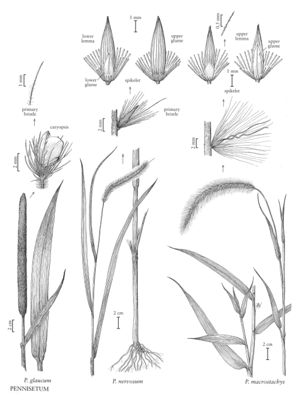Difference between revisions of "Pennisetum glaucum"
FNA>Volume Importer |
imported>Volume Importer |
||
| (2 intermediate revisions by the same user not shown) | |||
| Line 4: | Line 4: | ||
|publications= | |publications= | ||
|common_names=Pearl millet | |common_names=Pearl millet | ||
| + | |special_status={{Treatment/ID/Special_status | ||
| + | |code=I | ||
| + | |label=Introduced | ||
| + | }} | ||
|basionyms= | |basionyms= | ||
|synonyms= | |synonyms= | ||
| Line 16: | Line 20: | ||
-->{{Treatment/Body | -->{{Treatment/Body | ||
| − | |distribution=Wash.;Va.;Del.;D.C;Wis.;W.Va.;Conn.;Mass.;Maine;N.H.;R.I.;Vt.;Fla.;Wyo.;Puerto Rico;N.J.;N.Mex.;Tex.;La.;N.Dak.;Tenn.;N.C.;S.C.;Pa.;S.Dak.;N.Y.;Nev.;Ala.;Ga.;Iowa;Idaho;Kans.;Mich.;Minn.;Mont.;Nebr.;Okla.;Oreg.;Colo.;Calif.;Ark.;Ill.;Ind.;Ariz.;Md.;Ohio;Utah;Mo.;Miss.;Ky. | + | |distribution=Wash.;Va.;Del.;D.C.;Wis.;W.Va.;Conn.;Mass.;Maine;N.H.;R.I.;Vt.;Fla.;Wyo.;Puerto Rico;N.J.;N.Mex.;Tex.;La.;N.Dak.;Tenn.;N.C.;S.C.;Pa.;S.Dak.;N.Y.;Nev.;Ala.;Ga.;Iowa;Idaho;Kans.;Mich.;Minn.;Mont.;Nebr.;Okla.;Oreg.;Colo.;Calif.;Ark.;Ill.;Ind.;Ariz.;Md.;Ohio;Utah;Mo.;Miss.;Ky. |
|discussion=<p><i>Pennisetum glaucum</i>, a native of Asia, is cultivated in the United States for grain, forage, and birdseed. It is the most drought tolerant of the tropical cereal crops. Under favorable conditions, 10,000-30,000+ fascicles may be produced. In the Flora region, it is used for soil stabilization, partly because it seldom persists for more than 1-2 years.</p> | |discussion=<p><i>Pennisetum glaucum</i>, a native of Asia, is cultivated in the United States for grain, forage, and birdseed. It is the most drought tolerant of the tropical cereal crops. Under favorable conditions, 10,000-30,000+ fascicles may be produced. In the Flora region, it is used for soil stabilization, partly because it seldom persists for more than 1-2 years.</p> | ||
|tables= | |tables= | ||
| Line 34: | Line 38: | ||
|illustrator=Linda A. Vorobik | |illustrator=Linda A. Vorobik | ||
|illustration copyright=Utah State University | |illustration copyright=Utah State University | ||
| − | |distribution=Wash.;Va.;Del.;D.C;Wis.;W.Va.;Conn.;Mass.;Maine;N.H.;R.I.;Vt.;Fla.;Wyo.;Puerto Rico;N.J.;N.Mex.;Tex.;La.;N.Dak.;Tenn.;N.C.;S.C.;Pa.;S.Dak.;N.Y.;Nev.;Ala.;Ga.;Iowa;Idaho;Kans.;Mich.;Minn.;Mont.;Nebr.;Okla.;Oreg.;Colo.;Calif.;Ark.;Ill.;Ind.;Ariz.;Md.;Ohio;Utah;Mo.;Miss.;Ky. | + | |distribution=Wash.;Va.;Del.;D.C.;Wis.;W.Va.;Conn.;Mass.;Maine;N.H.;R.I.;Vt.;Fla.;Wyo.;Puerto Rico;N.J.;N.Mex.;Tex.;La.;N.Dak.;Tenn.;N.C.;S.C.;Pa.;S.Dak.;N.Y.;Nev.;Ala.;Ga.;Iowa;Idaho;Kans.;Mich.;Minn.;Mont.;Nebr.;Okla.;Oreg.;Colo.;Calif.;Ark.;Ill.;Ind.;Ariz.;Md.;Ohio;Utah;Mo.;Miss.;Ky. |
|reference=None | |reference=None | ||
|publication title= | |publication title= | ||
|publication year= | |publication year= | ||
| − | |special status= | + | |special status=Introduced |
| − | |source xml=https:// | + | |source xml=https://bitbucket.org/aafc-mbb/fna-data-curation/src/200273ad09963decb8fc72550212de541d86569d/coarse_grained_fna_xml/V25/V25_1354.xml |
|subfamily=Poaceae subfam. Panicoideae | |subfamily=Poaceae subfam. Panicoideae | ||
|tribe=Poaceae tribe Paniceae | |tribe=Poaceae tribe Paniceae | ||
Latest revision as of 17:56, 11 May 2021
Plants annual. Culms 50-300 cm, erect, branching; nodes glabrous. Sheaths glabrous or pubescent, with or without ciliate margins; ligules 2-5 mm; blades 15-100 cm long, 7-70 mm wide, flat, glabrous or pubescent. Panicles terminal, 4-200 cm long, 2-70 mm wide, fully exerted from the sheaths, erect; rachises terete, densely pubescent. Fascicles 33-160 per cm; fascicle axes 1-28 mm, persistent, with 1-9 spikelets; outer bristles 44-131, 0.5-6 mm; inner bristles 6-19, 4-6 mm, plumose; primary bristles 5.5-6.3, ciliate, some¬times noticeably longer than the other bristles. Spikelets 3-7 mm; pedicels 0.6-1.8 mm; lower glumes absent or to 1.5 mm, veinless; upper glumes 0.5-3.5 mm, 3-5-veined; lower florets staminate or sterile; lower lemmas 1.5-6 mm, glabrous, 3-7-veined, margins ciliate; lower paleas vestigial or fully developed, margins ciliate; anthers 2.2-2.5 mm, penicillate; upper florets coriaceous, shiny; upper lemmas 4.3-7 mm, 5-7(9)-veined, margins ciliate; upper paleas 3.4-3.9 mm, pubescent, at least near the base, margins ciliate; anthers 2-2.2 mm, penicillate. Caryopses 2-5.5 mm long, 1.6-3.2 mm wide, protruding from the lemma and palea at maturity. 2n = 14.
Distribution
Wash., Va., Del., D.C., Wis., W.Va., Conn., Mass., Maine, N.H., R.I., Vt., Fla., Wyo., Puerto Rico, N.J., N.Mex., Tex., La., N.Dak., Tenn., N.C., S.C., Pa., S.Dak., N.Y., Nev., Ala., Ga., Iowa, Idaho, Kans., Mich., Minn., Mont., Nebr., Okla., Oreg., Colo., Calif., Ark., Ill., Ind., Ariz., Md., Ohio, Utah, Mo., Miss., Ky.
Discussion
Pennisetum glaucum, a native of Asia, is cultivated in the United States for grain, forage, and birdseed. It is the most drought tolerant of the tropical cereal crops. Under favorable conditions, 10,000-30,000+ fascicles may be produced. In the Flora region, it is used for soil stabilization, partly because it seldom persists for more than 1-2 years.
Selected References
None.
